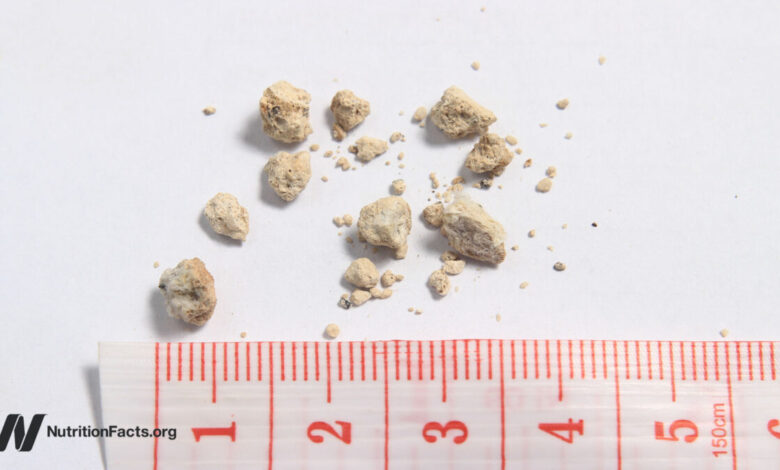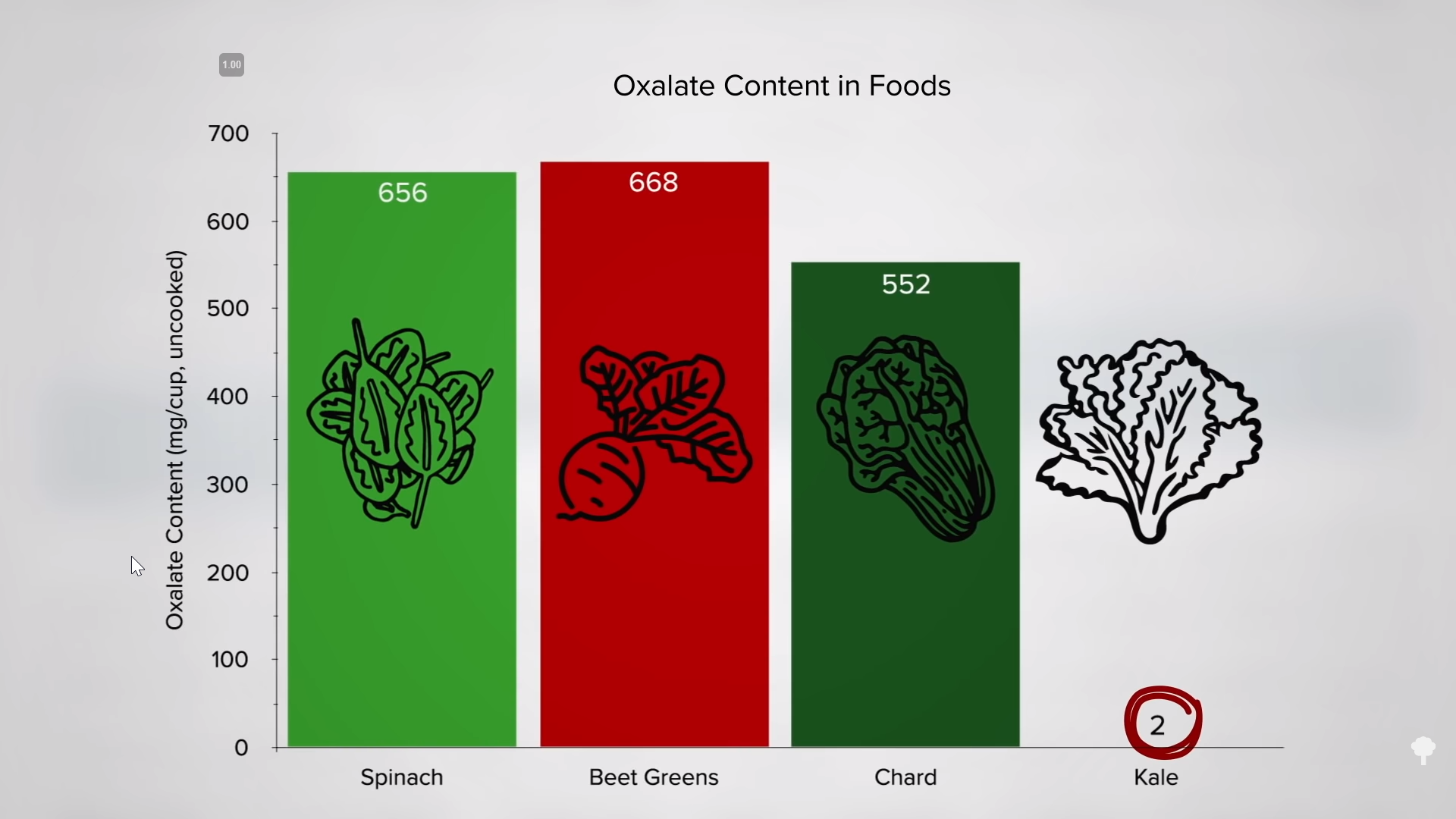High Oxalate Greens and Kidney Stones

Given their oxalate content, how much is too much spinach, chard, beet greens, chaga mushroom powder, almonds, cashews, star fruit, and instant tea?
There was a tragic case in which a “green smoothie cleanse” shut down the kidneys of a woman who had had two cups of spinach a day for just ten days. Complicating the matter, she had had gastric bypass surgery and was on prolonged antibiotics, both of which can increase the absorption of the oxalates in spinach. So, too, can taking mega-doses of vitamin C: A man juicing spinach and beet greens went into kidney failure, but he was also taking about 2,000 mg of vitamin C each day. Vitamin C is metabolized into oxalate inside the body and likely played a role in his oxalate overload. In both of these cases, the individuals were getting more than 1,200 mg of oxalate a day just from their juicing. As you can see in the graph below and at 0:50 in my video Kidney Stones and Spinach, Chard, and Beet Greens: Don’t Eat Too Much, that’s easy to do with spinach—it takes only two cups of spinach a day—but it’s practically impossible with most other greens. Kale, for instance, requires more than six hundred cups a day.

There is one case, however, of apparent dietary oxalate overload–induced kidney failure uncomplicated by surgery, antibiotics, or vitamin C: a man who had lost about 80 pounds eating a diet of berries, nuts, and greens, including spinach, six times a day. Tragically, his kidney function never recovered.
Remember that study that purported to show a “massive” load of dietary oxalate didn’t have much of an effect on urine levels? As you can see in the graph below and at 1:30 in my video, that study went up to 250 mg of oxalates a day. That is massive if you’re talking about most greens. For instance, to get 250 mg of oxalates, you’d need to eat 25 cups of collard greens, 60 cups of mustard greens, 125 cups of kale, or 250 cups of bok choy at a time, but less than half a cup of spinach.

Spinach really is an outlier. Even though there are small amounts of oxalates found throughout the food supply, spinach alone may account for 40 percent of oxalate intake in the United States. The Harvard cohorts found that men and older women who ate spinach eight or more times a month had about a 30 percent higher risk of developing kidney stones.
What if you cook the greens? Oxalates are water-soluble so, for example, blanching collard greens can reduce oxalate levels by up to a third. So, to reach 250 mg of oxalates, instead of 25 cups of collards at a time, it’s 33 cups! For low-oxalate greens, though, it doesn’t matter whether they’re cooked or not, since they’re so low to begin with.
As you can see below and at 2:33 in my video, steaming spinach reduces oxalate levels by 30 percent, and boiling cuts oxalate levels by more than half. Boiling any of the three high-oxalate greens—spinach, beet greens, and Swiss chard—results in 60 percent of the oxalates leaching into the cooking water. But, those greens start out so high that even when they’re cooked, they would contain hundreds of times more than low-oxalate greens like kale. For high-oxalate greens, though, it doesn’t matter whether they’re cooked or not, since they’re so high to begin with.

The bottom line is that anyone with a history of kidney stones, is otherwise at high risk, or eats cups a day should probably avoid the three high-oxalate greens. This is especially important for those who juice or blend their greens, as oxalates appear to be absorbed more rapidly in liquid than solid form.
Another reason to give preference to low-oxalate greens is that they are less stingy with their calcium. As you can see in the graph below and at 3:27 in my video, while less than a third of the calcium in milk may be bioavailable (whether from a cow or a plant), most of the calcium in low-oxalate vegetables is absorbed. The calcium bioavailability in some greens doubles that of milk, but the oxalates in spinach, chard, and beet greens bind to the calcium, preventing the absorption. 
Other high-oxalate foods that have been associated with kidney problems at high enough doses include chaga mushroom powder. Four to five teaspoons a day, and you can end up on dialysis. Four cups a day of rhubarb is also not a good idea, nor is more than a cup a day of almonds or eating that many cashews. Then there is star fruit. (You may have seen my video Neurotoxicity Effects of Star Fruit.) Consuming a single dose of about a cup and a quarter (300 mL) of star fruit juice, which is just four to six fruit, can lead to problems. Excessive intake of tea can also be a problem, especially instant tea, which boosts urine oxalate nearly four times higher than brewed tea. Two cases of kidney damage have been reported, both of which were attributed to drinking a gallon of iced tea a day. Tea, like spinach, is super healthy—just don’t overdo it.
If you missed it, be sure to check out my video Oxalates in Spinach and Kidney Stones: Should We Be Concerned?.
To be clear, I encourage everyone to eat huge amounts of dark green leafy vegetables every day, as they are the healthiest foods on the planet. But if you follow this advice—and I hope you do—choose a variety of greens, not only spinach, beet greens, and chard. If you only eat typical amounts of greens, like just one serving a day, then it doesn’t matter which ones you choose. I eat spinach, beet greens, and chard all the time, but it’s possible to overdo those three. When I’m trying to hit my pound-a-day green leafy quota, I mostly eat kale, collards, and arugula, which also happen to have the added benefit of being cruciferocious!
How are greens so good for us? How aren’t they?! Check the Related Videos below for more on this.
Also, look below for some tips on how you might prep them for maximum benefit.

